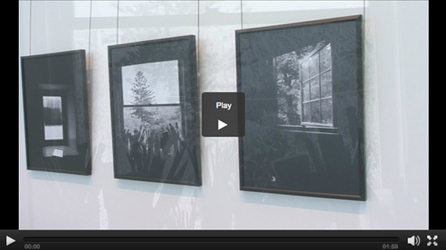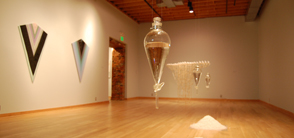Making Sense of Daily Life: Materials vs. Time and Space
By Susan Ren | B-More Art| August 4th
Young Blood 2014, the 7th annual student show held by the Maryland Art Place, exhibits the work of six recent MFA graduates in the Baltimore area, who explore how such intangible aspects of time, experience, memory, and interaction can be explained or changed with objects and aspects found in daily life. The collection of work is both conceptually intriguing as well as compositionally sound. Showcasing the innovating directions taken by rising artists to communicate through their craft, the exhibition ranges from more traditional works of drawings and paintings to experimental video and sculpture.
Claire Girodie’s appropriately titled miniature sculptures from her Resonant Whisper series, quietly tell faint stories to the viewer in passing – not with words, but with subtle imagery. The work’s small scale encourages a closer and more intimate viewing experience, softly enticing the observer to admire its simplicity. Crafted uniquely with traditional and delicate materials, each piece seems to evoke landscapes and familiar but unidentifiable figures from an old memory. Girodie has created an imaginative means to communicate. The fluent arrangement of materials surrounded by vast white space thoroughly depicts a “visual whisper.”
Dominique Zeltzman demonstrates inventive methods to address the cyclic and imprisoning nature of daily rituals in relation to objectification and power. Her imagery is strategically composed to uncomfortably “trap” her figure, revealing apparent items and symbols of femininity. Footage of her performing versions of mundane domestic chores is played on loop as if the television took control, alluding to the pressures created by politics and media to remain categorized by society’s constructed gender roles. In her newest piece Radical Home, videography, performance, and installation are cleverly merged in a timeline of still movements, creating an arrangement that allows the observer to dictate her actions – the task she performs is contingent upon which segment they choose to view. In these intelligent layers of action, time, space, and representation, Zeltzman unmistakably raises questions about societal containment.
Justin Hoekstra seeks to examine the cyclical and paradoxical nature of human existence in his abstract paintings that juxtapose different textures. His reference to the cycling of time is apparent, yet holds some ambiguity in its relation to a particularly human experience, as his textures seem to also evoke geological processes. The multiple layers of paint and erosion that mimic mechanisms of natural decay is an insightful means to reveal the chronology of his brushstrokes, allowing sections of the past and present to be visible, while their beginnings and ends remain indistinguishable. Though not an unprecedented stylistic breakthrough, his aesthetic is captivating and intricate across his body of work.
In the more literal paintings of Caleb Kortokrax, his exchange of time with various people, locations, and objects is documented as a still-frame image of one particular moment. Aside the other work being exhibited, this series stands out as being reminiscent of basic still life drawing or painting due to a lack of distinctive meaning. A definite style is present however, and the usage of materials is engaging, as working from observation allows Kortokrax to further extend his interactive process to the untraditional tools he uses to paint. His materials are indeed a notable part of his personal experience, but in the end the observer essentially sees an advanced version of painting from the environment.
Jim Leach humorously alters and misuses readymade items to intervene with the traditional language of form, function, and representation. His seemingly random combination of objects is in turn actually very strategic and adept. Within the sculpture, each object’s interaction with another determines its placement in the composition, while the entirety of each sculpture evokes new forms of machinery. Plastic Mother, for instance, is a wittingly constructed nonhuman presence that feels feminine, as if a robotic figure replaced the human. In his monolith-like and “pile of stuff” sculptures, Leach intuitively denies our preconditioned expectations for each readymade object.
Also looking to interfere with the language of function, Nick Primo purposely does not form three-dimensional shapes in his drawings, though they appear as if they should be simple perspective drawings at first glance. He presents a form of disorder that in turn reads as orderly – a paradoxical equilibrium found across all his work. His sculptures too, are designed to be useless, though unlike those of Leach, his arrangement of items is much more subtle and peaceful. The sculptures allude to, but still inappropriately use concepts related to function such as balance and symmetry, creating an abstract structure that is visually poetic and imaginative.
In a society where popular culture and media heavily influences basic human standards and conventions, it is important to stay grounded and continue to think independently and innovatively. The artists in Young Blood critique the nature of human interaction and experience, demonstrating varying but outstanding levels of inventiveness in their efforts to break the boundaries of traditional media and reinvent visual communication.
http://bmoreart.com/2014/08/making-sense-of-daily-life-materials-vs-time-and-space.html



.jpg)
.png)
.png)
